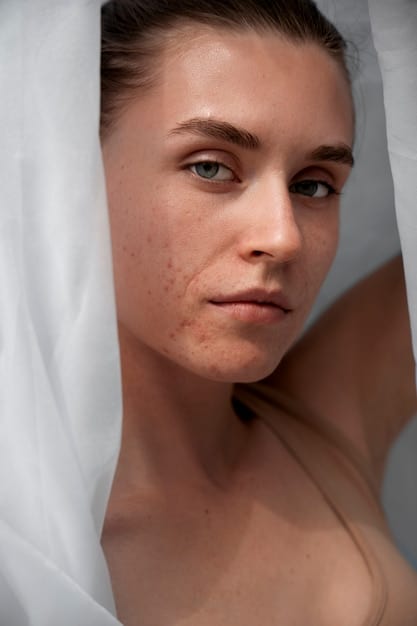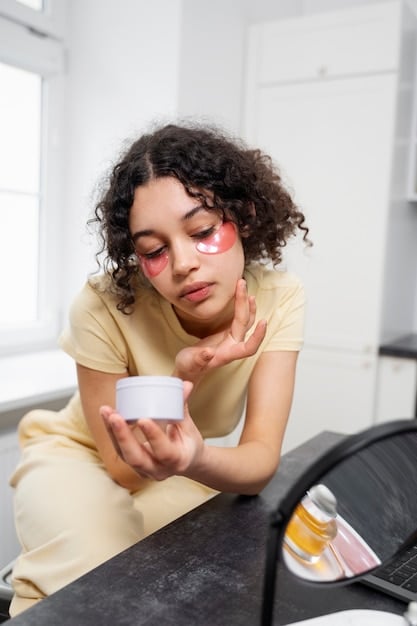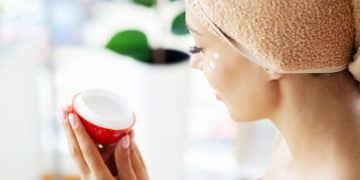Acne-Prone Skin? A Targeted Skincare Routine for Clear Skin

A targeted skincare routine is crucial for managing acne-prone skin, involving gentle cleansing, effective treatments like salicylic acid, hydration with non-comedogenic moisturizers, and consistent sun protection to clear breakouts and prevent future flare-ups.
Is your skin prone to breakouts? Dealing with acne-prone skin? A targeted skincare routine to clear breakouts and prevent future flare-ups can be frustrating and impact your confidence. But with the right approach, you can achieve clearer, healthier skin. Let’s explore a comprehensive skincare routine designed specifically for acne-prone skin.
Understanding Acne-Prone Skin
Acne-prone skin is characterized by frequent breakouts, including blackheads, whiteheads, pimples, and sometimes deeper cysts. Understanding the root causes of acne is crucial for developing an effective skincare routine.
What Causes Acne?
Acne typically arises from a combination of factors. Overproduction of sebum, the skin’s natural oil, can clog pores. Dead skin cells, if not properly exfoliated, exacerbate this issue. Bacteria, particularly *Cutibacterium acnes* (formerly known as *Propionibacterium acnes*), can thrive in clogged pores, leading to inflammation.
Common Triggers for Acne
Hormonal fluctuations, especially during puberty, menstruation, pregnancy, or menopause, can trigger acne. Certain medications, such as corticosteroids or lithium, may also contribute. Diet, although not a direct cause, can influence acne; high-glycemic foods and dairy may worsen symptoms for some individuals. Stress can also indirectly affect acne by influencing hormone levels and immune function.
- Excess Sebum Production: Understanding how sebum contributes to clogged pores.
- Dead Skin Cell Buildup: Why exfoliation is important for acne-prone skin.
- Bacterial Involvement: The role of *C. acnes* in inflammation and breakouts.
- Hormonal Impact: How hormones influence sebum production and acne.
Identifying these causes and triggers can help you tailor your skincare routine to address your specific needs. For instance, if hormonal fluctuations are a major factor, consulting with a dermatologist or endocrinologist might be beneficial.
The Core Steps: A Daily Routine
Consistency is key when it comes to managing acne-prone skin. A well-structured daily routine incorporating cleansing, treatment, moisturizing, and sun protection can make a significant difference.
Cleansing: Gentle is Key
Choose a gentle, non-comedogenic cleanser to remove dirt, oil, and makeup without stripping the skin of its natural moisture. Over-cleansing can irritate the skin, leading to more breakouts. Look for cleansers with ingredients like salicylic acid or benzoyl peroxide, which can help unclog pores and reduce inflammation.
Treatment: Targeted Solutions
Incorporate targeted treatments that address specific acne concerns. Salicylic acid is effective for mild to moderate acne, helping to exfoliate the skin and unclog pores. Benzoyl peroxide is a powerful antibacterial agent that can reduce inflammation and kill acne-causing bacteria. Retinoids, such as tretinoin or adapalene, can help prevent new breakouts and improve skin texture. Start with a low concentration and gradually increase as tolerated to minimize irritation.

- Morning Cleansing: Focus on removing oil and impurities accumulated overnight.
- Evening Cleansing: Prioritize removing makeup and environmental pollutants.
- Treatment Application: Apply targeted treatments after cleansing and before moisturizing.
- Spot Treatments: Use spot treatments for individual pimples as needed.
Maintaining a consistent daily routine ensures that your skin receives the care it needs to stay clear and healthy. Adjusting the products and their concentrations based on your skin’s response is crucial for long-term success.
Weekly Exfoliation: Sloughing Off Dead Skin
Exfoliation is a crucial step in any skincare routine for acne-prone skin. It helps remove dead skin cells that can clog pores and contribute to breakouts.
Physical vs. Chemical Exfoliants
Physical exfoliants, such as scrubs with beads or brushes, can manually remove dead skin cells. However, they can sometimes be too harsh for sensitive, acne-prone skin. Chemical exfoliants, like AHAs (alpha hydroxy acids) and BHAs (beta hydroxy acids), offer a gentler alternative. AHAs, such as glycolic acid and lactic acid, exfoliate the skin’s surface, while BHAs, such as salicylic acid, penetrate deeper into the pores to dissolve oil and debris.
Choosing the Right Exfoliant
When choosing an exfoliant, consider your skin’s sensitivity level. Start with a low concentration and gradually increase as tolerated. Avoid over-exfoliating, as this can irritate the skin and worsen acne. A good approach is to exfoliate once or twice a week, depending on your skin’s needs.
- Gentle Scrubbing: If using a physical exfoliant, apply gentle pressure in circular motions.
- Chemical Exfoliation Frequency: Start with once a week and increase as needed.
- Avoid Over-Exfoliation: Watch for signs of irritation, such as redness and peeling.
- Patch Test: Test new exfoliants on a small area of skin before applying to the entire face.
Incorporating exfoliation into your weekly routine can significantly improve skin texture and reduce the frequency of breakouts. Remember to always follow up with a moisturizer to keep your skin hydrated.
Hydration and Moisturizing: Essential for Balance
Many people with acne-prone skin mistakenly believe that moisturizing is unnecessary. However, keeping the skin hydrated is essential for maintaining a healthy skin barrier and preventing excess oil production.
Why Moisturizing is Important
When the skin is dry, it can trigger the sebaceous glands to produce more oil, which can clog pores and lead to breakouts. A non-comedogenic moisturizer can provide hydration without contributing to acne. Look for moisturizers with ingredients like hyaluronic acid, glycerin, and ceramides, which help to draw moisture into the skin and strengthen the skin barrier.
Choosing the Right Moisturizer
Opt for lightweight, oil-free moisturizers that won’t clog pores. Gel-based or lotion-based formulations are often a good choice for acne-prone skin. Avoid heavy creams and balms, which can be too rich and occlusive. Apply moisturizer after cleansing and applying any targeted treatments.

- Morning Moisturizing: Apply after cleansing and before applying sunscreen.
- Nighttime Moisturizing: Apply after cleansing and applying any treatments.
- Non-Comedogenic Formulas: Ensure your moisturizer is labeled as non-comedogenic.
- Lightweight Textures: Choose gel or lotion-based moisturizers over heavy creams.
Proper hydration is key to maintaining healthy, balanced skin. By choosing the right moisturizer and incorporating it into your daily routine, you can help prevent breakouts and improve your skin’s overall appearance.
Sun Protection: A Non-Negotiable Step
Sunscreen is a crucial part of any skincare routine, but it’s especially important for acne-prone skin. Many acne treatments, such as retinoids and AHAs, can make the skin more sensitive to the sun.
Why Sunscreen Matters
Sun exposure can cause inflammation, which can worsen acne. It can also lead to hyperpigmentation, or dark spots, from healed acne lesions. Additionally, some acne treatments increase the skin’s vulnerability to UV rays, making sun protection even more critical.
Choosing the Right Sunscreen
Opt for a broad-spectrum sunscreen with an SPF of 30 or higher. Look for oil-free and non-comedogenic formulations to avoid clogging pores. Mineral sunscreens containing zinc oxide or titanium dioxide are often a good choice for sensitive, acne-prone skin, as they are less likely to cause irritation. Apply sunscreen liberally to all exposed skin, including the face, neck, and ears, every morning and reapply every two hours, especially if you’re spending time outdoors.
- Broad-Spectrum Protection: Ensures protection against both UVA and UVB rays.
- Oil-Free Formulas: Avoid sunscreens that contain oils that can clog pores.
- Daily Application: Make sunscreen a part of your daily morning routine, even on cloudy days.
- Reapplication: Reapply every two hours, or more often if swimming or sweating.
Sun protection is not only essential for preventing skin cancer and premature aging but also for managing acne. By incorporating sunscreen into your routine, you can protect your skin from sun damage and minimize acne flare-ups.
Lifestyle Adjustments: Supporting Clear Skin
In addition to a consistent skincare routine, certain lifestyle adjustments can support clearer skin. These include dietary changes, stress management techniques, and ensuring adequate hydration.
Dietary Considerations
While diet isn’t a direct cause of acne, certain foods can exacerbate symptoms for some individuals. High-glycemic foods, such as sugary drinks, white bread, and processed snacks, can cause spikes in blood sugar levels, leading to inflammation and increased sebum production. Dairy products may also worsen acne for some people due to their hormonal content. A balanced diet rich in fruits, vegetables, whole grains, and lean protein can support overall skin health.
Stress Management
Stress can trigger hormonal imbalances that can lead to acne. Incorporating stress management techniques into your daily routine can help reduce breakouts. Meditation, yoga, deep breathing exercises, and regular physical activity are all effective ways to manage stress levels. Getting enough sleep is also crucial for overall health and can help regulate hormone levels.
- Limit Sugary Foods: Reduce intake of high-glycemic foods and drinks.
- Stay Hydrated: Drink plenty of water to keep skin hydrated and flush out toxins.
- Incorporate Relaxation Techniques: Practice meditation, yoga, or deep breathing exercises.
- Ensure Adequate Sleep: Aim for 7-8 hours of sleep per night.
By making these lifestyle adjustments, you can create a holistic approach to managing acne-prone skin. Combining a consistent skincare routine with healthy lifestyle habits can lead to clearer, healthier skin.
| Key Point | Brief Description |
|---|---|
| 🧼 Gentle Cleansing | Use a mild, non-comedogenic cleanser twice daily. |
| 🧪 Targeted Treatments | Apply salicylic acid or benzoyl peroxide to problem areas. |
| 💧 Hydration | Moisturize with a lightweight, oil-free formula. |
| ☀️ Sun Protection | Use broad-spectrum, oil-free sunscreen daily. |
Frequently Asked Questions
▼
Wash your face twice a day, in the morning and evening, to remove excess oil and impurities without over-drying the skin.
▼
High-glycemic foods and dairy may worsen acne for some. Consider limiting these to see if your skin improves.
▼
No, popping pimples can lead to inflammation, scarring, and more severe breakouts. It’s best to let them heal on their own.
▼
Seek products with salicylic acid, benzoyl peroxide, or retinoids to help treat and prevent acne breakouts effectively.
▼
It may take several weeks or months to see noticeable improvements. Consistency and patience are important when starting a new routine.
Conclusion
Managing acne-prone skin requires a consistent and targeted approach. By incorporating a gentle cleansing routine, using effective treatments, maintaining hydration, and protecting your skin from the sun, you can achieve a clearer, healthier complexion.





